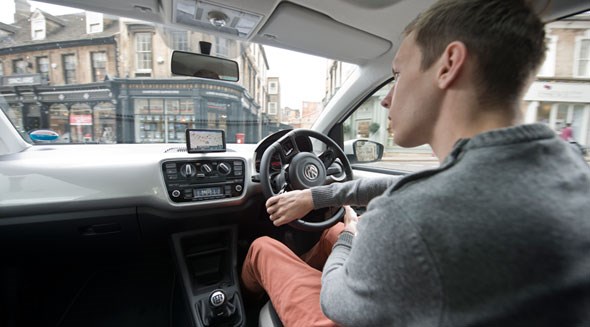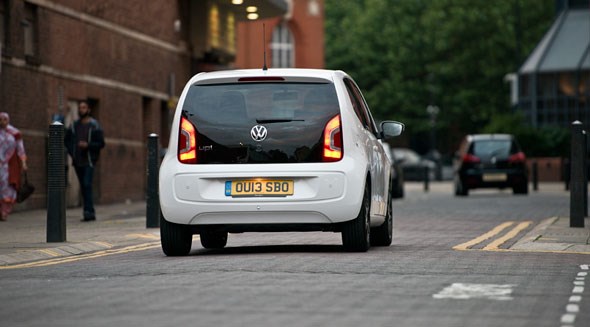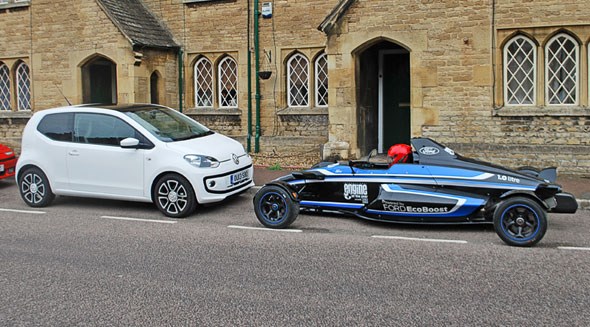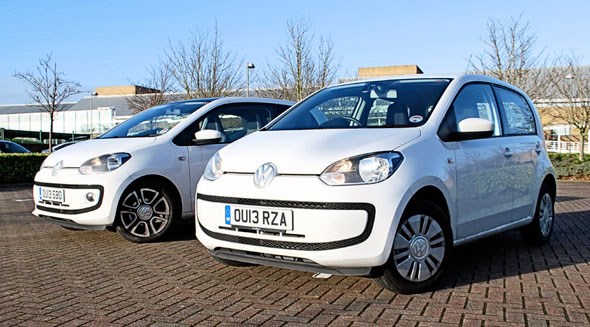Month 11 running a VW Up: the final report
It’s a measure of how accomplished the Volkswagen Up is – and how satisfying it’s been to run one for ten months – that it’s much easier to quickly reel off the short list of things I wasn’t keen on than ramble endlessly about all its plus points. The holes in the boat are: the penny-pinching decision not to fit dual electric window switches to the driver’s side door. The Bluetooth system’s habit of cutting out and skipping during iPhone music playback. I’d sacrifice a smidge of steering lock for a quicker rack to suit the agile, chuckable chassis, which shines when fitted with the 15mm lower, stiffer suspension of the £480 Sport Pack modelled by this example. Worst of all was the disappointing fuel consumption, which never cracked a 50mpg average (in fairness, I didn’t specify the fuel-saving Bluemotion pack, with eco tyres and stop-start).
Other than that, I’m struggling. During the Up’s stay at CAR I drove all of its key rivals, from its Skoda Citigo twin and the mighty accomplished new Hyundai i10 to the disappointing Vauxhall Adam, and Fiat’s evergreen 500 and Panda. All have charm, and a degree of sophistication that means city car-buyers are no longer left feeling like the butt of a manufacturer’s satisfaction survey jokes. But none convinced me they were superior to my High Up, which, sporting heated seats, air-con, sat-nav, privacy glass, upgraded stereo and leather trim, never felt like a budget ride. Despite being the cheapest member of the Our Cars fleet by a good £2355, as tested.
But the Up was the slowest, and I won’t miss the gutlessness of 74bhp at a naughty, rorty 6000rpm. No-one – even me – expects a dinky runaround to scarper faster than 1970s BBC personality when the doorbell rings, but spending a week driving the Up’s all-electric brother, the e-Up, confirmed my suspensions that a dash of extra power would turn up the fun.
Though the e-Up (no Yorkshire jokes, I’ve heard them all) weighs a titanic 200kg more than a petrol one thanks to its battery pack, it’s much faster. You get twice the torque (!), and having enough poke to illuminate the long-dormant traction control light is guilt-free fun. The front wheels’ e-motor develops 155lb ft from 0rpm, and you don’t need my B in GCSE mathematics to work out that makes for sprightlier getaway than the three-pot’s 70lb ft at 3000-4000rpm.
Think that’s where the e-Up’s novelty act ends? Think again. Though its real-world range is only about 90 miles (the petrol car managed a best of 330 miles to a tank in my hands), it’s faster, costs only a couple of quid to fully charge, and the lack of drivetrain grumble highlights just how quiet and well screwed-together the Up is. For 75% of the journeys my long-termer’s completed over the past 5300 miles (14-mile commutes, about-town errands, even working as a tracking and support hack on CAR’s photoshoots) the e-Up would’ve been quicker, and cost less to run. Food for thought indeed, though you’ll have to rack up serious mileage some to offset the ‘lil leccy’s £19,250 asking price.
Which leaves us back with the petrol car, and that’s fine with me. Wearing the classiest badge and unfussiest suit in all city car-dom, the Up is a cracking little drive, surprisingly practical, and a high-quality product. Only a dodgy seatbelt warning bonger let that side down (traced to an unresponsive seat sensor; am I that underweight?) as did a muted sat-nav that the excellent dealer cured with a software update. That same VW dealer would be getting my £12k if I was off to buy a city car tomorrow.
By Ollie Kew
Month 10 running a VW Up: our time is nearly at an end
Time is almost Up for the you-know-what. It’ll soon be leaving my custody, and be deservedly missed. In its twilight hour, it’s opportune that I air my biggest grievance with what is a cracking city car. There’s no hot version to aspire to – yet. VW insiders tell me development of the turbo’d 110bhp Up GT was halted, because the sums of creating a bespoke bodykitted flagship, packing a one-model-only engine, didn’t add up. However, the appearance of a 1.0-litre turbo triple in the facelifted Polo line-up has reignited hopes of a fast Up. Until then, VW’s entry-level hot hatch remains the Polo GTI, which costs almost twenty grand.
From a company that’s prepared to feed financial black holes such as the Bugatti Veyron, VW Phaeton and, ahem, Seat, that’s unforgivable. How about a little power for the people? VW’s baby is deft, chuckable, and foolproof; it even rides decently on ‘my’ big alloys and sports suspension. This is a chassis crying out for a dash more power like Man Utd needs a decent centre-mid. It’s a scandal that the Lupo GTI’s grandson has been delayed this long.
To satisfy my appetite for a lightweight, guilt-free power trip, I popped onto the classifieds and started ‘just browsing’ Lotus Elise S2s. And then I ‘just went for a test drive’. And shortly thereafter, found myself ‘just signing the V5’ on a smart 2002 S2. Oops. It weighs 200kg (!) less than the Up, and musters 120bhp – only 10bhp more than the Up GT would’ve enjoyed. Result? A young buck’s perfect two-car garage – for one month only.
By Ollie Kew
Month nine running a VW Up: how economical is our VW city car?
Elephant in the room time. The Up should, at a canter, be the most economical machine on the CAR fleet. VW claims it’ll do 60mpg in a lab, and on paper, a 999cc triple tugging 935kg of hatch is a more-or-less teetotal combination. Yet off the paper and on the road, my best result has been 48.7mpg, and the more representative overall average about 44. Apologies, student finance, but don’t expect a cough-up from me in the near future.
Delivered box-fresh, the car was sympathetically run in, and isn’t, I promise (officer), driven like a Mediterranean hire banger late for a final boarding call. My commute is only a 14-mile motorway hop, albeit with precious little distance for the diminutive engine to warm up first.
I’m disappointed. I expected (and achieve) better results than CAR’s Fiat Panda TwinAir’s pathetic 37mpg average, but the VW likes a drop more often than my post-uni self. Any Up owners out there care to set me straight? Tweet me your best figures and I’ll endeavour to beat ’em.
By Ollie Kew

Month eight running a VW Up: which Ups people actually buy
Back when I introduced the Up I crowed that it was the most attractive example I’d seen, satisfied with my performance on the VW configurator. Seven months later though, it’s unnerving how few ‘High Ups’ I see kicking about. The majority of Ups, and its Skoda Citigo and Seat Mii sisters, are basic cars on plastic hubcabs, naked of chrome trim, foglights and tinted glass.
A chat with VW confirmed my suspicions –25% of UK Ups are High – the sweet spot is the £1500 cheaper middling Move Up, swallowing nigh-on 50% of sales. Same story for Skoda and Seat’s badge-engineered babies, and as much as I appreciate my Up’s tasty spec, I see the sense in the buying public’s taste. The performance difference gained from the top-spec 74bhp engine compared to the others’ 64bhp tune is negligible (blame identical torque outputs), while heated seats, nav and alloys just don’t feel essential in a device whose raison d’etre is affordability. Recently I caught up with a mate who’s run a spartan Seat Mii S since new. Nothing’s fallen off or gone wrong. After 8500 miles, his only complaint? There’s no clock. I’m 22 years young and here’s my first ‘cheap = cheerful’ verdict. Thanks, austerity Britain.
By Ollie Kew
Month seven running a VW Up: dealer service in our Up
‘It’s a Polo’. I hid my satisfaction with Robinsons VW of Stamford’s courtesy car offer well. While their technicians babysat the misbehaving Up, I had at least a day to draw comparisons with its bigger, pricier supermini stablemate.
Inside, the 5700-mile old 13-reg Polo presented all the usual granite bank-vault quality cliches, and the same level of visual interest. Blimey, it’s dull in there. Compared to the Up’s body coloured door tops, contrast silver dashboard panel (much prettier than it sounds) and retro seats, the Polo verged on depressing, like the Golf used to before it morphed into a quasi-Phaeton environment of crisp coolness. Being a lowly ‘S’ model, (the silver R-line Polo pictured was cunningly posed next to my Up upon collection time, but don’t be fooled) its contact points immediately felt cheaper: plastic rather than leather steering wheel and gearstick, and fewer pieces of tactile metal trim.
And to drive? Supremely refined. That goes for the powertrain, ride, ambient noise and control feedback. But in creating a mini-Golf (not to be confused with the seaside attraction), the Polo’s become the most joyless small car I’ve ever driven. Usually, even the shonkiest superminis are a fun steer thanks to small dimensions, low weight, and modest grip. The 70lb ft, six-valve Up might have felt like its handbrake was stuck on after swapping back from the 83lb ft, 12-valve Polo, but at least it maintains some pretence of ‘I’m game for a laugh if you are’.
Meanwhile, the Up’s rogue seatbelt warning played hide-and-seek during the dealer visit, but the techies fiddled with the seat base ‘arse sensor’ (™) to cure it. The muted sat-nav was traced to the need for a software update, and the plastic base working loose on the move. I feared my sports suspension’s more brittle ride was to blame, but Robinsons reassured that, although mine is the first Sports Pack-equipped Up they’ve remedied, it’s not their first sat-nav complaint. Since the nav caught a cold, I’ve prodded it with surgical delicacy, for fear of knocking it and muting Alan Dedicoat permanently.
I’ve long thought the space-saving dash-top plinth for the Maps & More system is a weak spot: from day one I’ve been paranoid that a non-CAR-reading scallywag would mistake it for a carelessly left-on-display TomTom, and break in to seize it. Somewhat irresponsibly, I decided never to remove the screen when the car was parked, to discover if my fears would be realised. Devil’s advocate has so far not provoked a smash-and-grab raid.
Oh, and Robinsons kindly washed the Up for me to, so its cheeky face no longer resembles the grime and fly-spattered nose of an InterCity 125 idling at Kings Cross. Great service all round. One more thing – it’s now winter and the nuclear heated seats are some of the best I’ve used in any car at any price. On the down side, the diddy 999cc engine takes eons to generate enough heat to defrost the windscreen. Brrr!
By Ollie Kew

Month six running a VW Up: meeting a Formula Ford
I haven’t the space to tell you about the Up’s dealer visit here, so that’s for next month. Wait! Before you skip straight onto the Range Rover report: we’ve had another 1.0-litre three-cylinder car join the Up at CAR HQ recently, and it’s not been the supermini showdown you’d expect.
The wing-clipped F1-car lookalike pictured is in fact a Formula Ford. A rather canny marketing exercise to showcase the best of Ford’s own three-pot, it packs the ultimate version of the Blue Oval’s 999cc engine. Tuned for 250bhp (and pushing along bang-on half the Up’s weight, at 465kg), the FF1 is good for a 7:24 Nürburgring lap. Hilariously/terrifyingly, it’s road legal. Ford’ll knock you one up for about £80k.
While you can buy myriad Fords with related tri-banger power (Fiesta, Focus, B-Max), only the Up uses VW’s version of the template. Being naturally aspirated, it longs for overtaking grunt, but everyday mpg figures are more realistic than turbos, which naughtily run off-boost under the EU test microscope. A Formula for success?
By Ollie Kew

Month five running a VW Up: just how practical is VW's city car?
For one month only I’m delivering my Up-date using the same delivery method favoured by Gordon Brown’s No10 advisors: the sh*t sandwich. You start with the good news, then the bad, and finally some encouragement to reanimate the smile-o-matic.
First off, it ain’t half useful, the Up. If Peter Capaldi fancies getting into character for his new Timelord role, I suggest a weekend in one: it really does feel bigger inside than those dinky proportions suggest. So commodious in fact, the Up’s doubled this month as a pit support wagon to cart my old Ford Puma’s refurbed alloys around, then as a family taxi ferrying the Kew clan to the cinema. My folks’ Nissan Juke was on the driveway too, but with less leg- and headroom for passengers, it got left behind. It also manages half the economy of the Up – hold that thought.
Incidentally, we watched Behind the Candleabra. Now, I don’t profess to be as deft with a set of pedals as ‘Mr Showmanship’, but with 1866 miles under its wheels, the VW is steadily climbing the mpg ladder. But wait, news just in…
Tank-to-tank, I’ve scored a personal best of 49.8mpg. However, the devious dashboard readout massages my ego, promising a 52.3mpg average. Certainly lies like a politician, then. The other niggle is an intermittent seatbelt warning fault which, in classic electrical error fashion, only bongs away when I’m driving one-up. It’s occurred twice, cured by Chapter One, Verse One of The Gospel According To IT: switch off and on again.
Otherwise, all is stupefyingly well in Up-land. Perhaps I’ll overhear it slagging me off by next month, and have a reason to reduce its poll numbers.
By Ollie Kew
Month four running a VW Up: steering wheel lovely, but steering too slow
Swapping Up impressions with my opposite number (experience-wise) at CAR, Greg Fountain and I largely agreed VW has nailed its third attempt at a city slicker, after the pricey Lupo, and not-so-cunning Fox. He concluded in a sage tone, bringing to mind his Game of Thrones double Lord Varys: ‘It would be unwise to pick fault with that car’. Perhaps The Hand of the Editor will have my head for this, but I’ll bite. I’m not getting along with the Up’s steering.
VW equips Ups with a long-winded, 2.9-turn rack, affording a 9.8m turning circle. A London cabbie would approve, but I don’t guvna. Too much input is required, even when not pivoting around the proverbial sixpence. That short-overhang stance and stiffer suspension should bless the Up with Scalextric-esque agility, but the steering spoils its nimbleness. Pity, given the slim-rimmed, flat-bottomed wheel is a standout delight in a car teeming with thoughtful design. Thumbs up, however, go to the Sports Pack. Lowered, less compromising springs prohibit cornering roll, at the negligible expense of comfort – cheekily cocking a rear wheel hasn’t been this easy since France’s hot-hatch halcyon. The £480 Sports Pack is also the only way to bag the nice rims and tinted glass.
By Ollie Kew
Month three running a VW Up: driving the Up’s enemy within
When is a VW Up not a VW Up? When it’s a Skoda Citigo, of course. Or, for that matter, a Seat Mii. Three VW Group brands riff a city car off the three-cylinder, boxy-shape underpinnings, though it’s the Up, with VW’s domineering hand on the styling crayon, that looks most cohesive. Still, all share the 1.0-litre engines, running gear and rock-solid cabin, so your choice comes down to styling preference, badge snobbery and the proximity of your local dealer.
There’ll never be a hot Up – the Up GT has been canned due to budget constraints, killing any notion of a Seat Cupra or Skoda vRS version. Nevertheless, Skoda has had a crack at a racier-looking version: the Skoda Citigo Sport. It gets the same lowered, stiffer suspension as our Up long-termer, plus racing stripes, red stitching and a hilarious bodykit. The rear diffuser was in for a shout as most pathetic piece of fake aero car attire ever, until I spotted the snowplough-cum-splitter up front. Still, on its glossy black wheels, it looks pretty cool in a pugnacious, cheeky way.
Inside, the Sport loses out on spec to ‘my’ top-spec ‘high Up’. No electric mirrors, no heated seats, and only the 64bhp engine, rather than my Up’s 74bhp mill. However, you still get sat-nav and Bluetooth, as well as a big cost saving. A Citigo Sport is £10,290: £710 less than a base-spec high Up, before you’ve added the VW’s £480 Sport Pack. Depending on your driving style, that could be a year’s worth of fuel.
And to drive? No surprises, the Citigo Sport feels just like the Up. Except for one thing – it just isn’t any slower. The 10bhp deficit is inconsequential because the 74bhp engine develops peak power at 6200rpm, while the 64bhp engine gives its best lower down, from 5000-6000rpm. Plus, both engines develop an identical 70lb ft, over the same 3000-4300rpm range. So, in everyday driving, the extra power is completely unnoticeable. It pays to read spec sheets.
If it were my money on the dotted line, having driven both, I’d find it difficult to walk past the Skoda forecourt, despite preferring the Up’s styling and badge. The Skoda just makes better value sense – and doesn’t have a grammatically incorrect name, which is nice.
By Ollie Kew

Month two running a VW Up: the full introduction to our new Up
Before I properly introduce our newest long-termer, I’ll quickly say ‘hello’: I’m CAR’s staff writer, drafted in during the mayhem of the 50th anniversary in 2012, and fortunate enough to stick around after the corks had popped and Ben Pulman’s cover shoot-induced nervous breakdown subsided. Craving a new source of stress, he’s entrusted me with the baby Volkswagen and a mission to discover: is this the world’s best city car?
First, the disappointment: the ‘up!’ (which will never again be referred to here as such a grammatical abomination) isn’t the pint-sized revolutionary it could’ve been. The concept’s classic Beetle-style rear-engine/rear-drive set-up was binned for front-drive gubbins shared with the Polo – though it did leave an echoingly deep 251-litre boot behind.
Never mind, conventional means class-leading here. The all-new, all-alloy 999cc three-cylinder petrol comes in entry level 64bhp or 74bhp tunes, but only the higher-powered one is available in this top-spec ‘High up!’ (aargh) which gets alloys, cow-covered steering wheel and handbrake, and front foglights, plus heated seats, air-con, a well-worth-it six-speaker stereo upgrade, and the ‘Maps & More’ portable infotainment centre. The wafer-thin screen crams in iPod and Bluetooth connectivity, sat-nav, voice control and a ‘help me drive economically’ app. My first car, back in 2011, was an S-reg Ford Ka. In comparison the mature, kitted-out VW feels like an S-class. Even city cars spoil us rotten now.
With darkened glass and blank paint I worried the slab-sided Up would look a bit of a van, but I reckon it’s the sharpest (and most masculine) spec I’ve seen: the rare Sports Pack rims set it off to a tee. My only options-list faux-pas was sidestepping ‘Bluemotion Technology’, offering low-resistance tyres, regenerative-brake battery charging, and stop/start. Still, it’s an extra £360, and I’m damned if I’m having a narcoleptic engine take credit for my economy figures.
Ah yes, the frugality. Though my Up arrived box-fresh with just 94 miles showing, I’m already closing in on 50mpg – in fact I’ve a longer range than our Aston DB9, which dares to call itself a grand tourer. I suppose that’s faster, but so’s everything. I’ve swapped my own Ford Puma 1.7 for the Up, and I miss its sharp, Yamaha-tuned throttle and 123bhp already. Don’t wait, er, up.
By Ollie Kew
Month 1 running a VW Up: the Up is caught by a spy photographer’s lens
The Up has barely settled into its new life as a CAR magazine long-term test car, and already it’s become the star of its very own spy scoop. One of CAR’s intrepid test-mule snappers got a tip-off I’d be heading to Jaguar Land Rover headquarters in Gaydon, Warwickshire this week, and lurked in the undergrowth to catch OU13 SBO going about its business. Must’ve been the car’s unique spec (have you seen another one identical to this?) of Candy White paint and Sports Pack alloys that gave me away.
So far as the Up itself is concerned, it’s so far, so good. After piling on over 2000 miles in only three months, the willing 1.0-litre three-cylinder engine has finally loosened up, encouraging jaunts into the top half of the rev range to unleash that offbeat, ‘half-a-911’ thrum. On the flipside, it’s getting close to 50mpg in everyday driving after some initially disappointing figures, and VW’s claim of 60.1mpg doesn’t feel like a fantasy target: take note, Fiat Panda TwinAir.
We’ll be adding more updates to the baby VW’s page soon, so stay tuned to CAR Online to find out more. In the meantime, check out the September issue of CAR magazine, which features the complete ‘Hello’ welcome of the Up, including why I reckon it’s a better grand-tourer than our Aston Martin DB9…
By Ollie Kew
Speccing CAR's new VW Up long-termer
What made choosing the options on CAR’s new VW Up so easy was the sheer amount of kit included as standard with the engine option we were after. VW offers the Up with a choice of two 1.0-litre three-cylinder petrol engines, one good for 64bhp, the other a better motorway companion, with 74bhp. Cynically, VW only lets you choose the uprated engine in top-spec ‘High Up’ trim, and woe, that’s exactly what we’ve plumped for.
‘High Ups’ enjoy, in conjunction with a horrid pun-tastic name, air-conditioning, heated seats, the ‘Maps & More’ sat-nav infotainment touchscreen, 15in alloys, and electric front windows. There’s a touch of leather upholstery too: for the steering wheel and handbrake trim. As a three door, it’ll set you back £10,900.
So, to the options list dabble. First, the white paint, selected partly because it photographs well, and partly because it suits the Up’s industrial clean lines, like a sort of four-wheeled, internal-combustion iPod. Satisfaction with the colour is slightly tarnished by VW’s audacity to charge £250 for it.
Next up, I went for the £480 Sports Pack. Visually set apart by polished black 16in alloys and tinted rear glass, it also endows the Up with a 15mm ride height drop and stiffer spring rates. Standard Ups, Skoda Citigos and Seat Miis are already well-damped (if slightly bouncy) contraptions, so it’ll be interesting to see if the Sports Pack spoils the fun, or adds more of it.
Making motorway jaunts a little more tolerable is cruise control, which comes as part of the sensor pack for £355, along with thoroughly unnecessary rear parking sensors. Oh, and we dropped a not insubstantial but well worth-it £650 on the electrically retractable glass sunroof. Handy for airing out the cabin in a heatwave, given that VW’s penny pinchers didn’t fit dual electric window switches on the driver’s door…
All in, this rather tasty Up spec equals £12,640 – a lot, for a 999cc city car, but it does have all the desirable kit you could ever want in a city slicker, and badge kudos its French and Korean rivals can only lust after.
Will that translate into a satisfying, enjoyable ownership experience? Will the sports suspension expose flaws in the seemingly bulletproof build quality? And surely we can’t score the claimed 60.1mpg, right?
Stay tuned to CAR Online and CAR magazine to find out.
By Ollie Kew